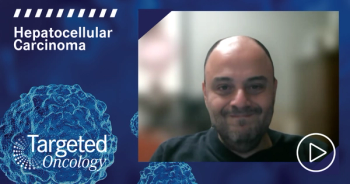
Richard Finn, MD: Interventional Radiology and Local/Regional Therapy
How does interventional radiology (IR) figure into the local/regional therapy of this patient with uHCC?
So he has a liver confined tumor, and it’s very reasonable to consider local regional therapy. Strictly speaking by the Barcelona Criteria, this patient might be considered Barcelona C, given that they have performance status of 1 and symptomatic disease. But, again, it is confined only to the liver and local regional therapy, I think, would be considered by many physicians and multidisciplinary tumor boards as something to consider.
So, as we learn, the patient undergoes a chemoembolization procedure. The majority I think of the patients we see in managing this disease do present with disease that is treated with local regional therapy. In that regard, interventional radiology is a key component of any multidisciplinary tumor board. As we learn in this case, the patient had a chemoembolization. Chemoembolization has been shown to improve survival in patients with organ confined disease, though typically a patient with this size tumor would have been excluded from the randomized prospective studies that showed a survival benefit with TACE. But, needless to say, they undergo local regional therapy and we learn on follow up imaging that there’s residual disease and perhaps some residual satellite lesions or even new lesions.
The question is what do we do next for this patient. I think seeing a 12 cm lesion on a scan and in sending that patient for local regional therapy, most of us would not expect them to have a complete response to one round of TACE. A lesion this size likely would require more treatment. The question here is should we do another TACE or move on to another treatment option. Keep in mind in the United States largely TACE is not done with a predetermined number of TACE. Again, that is different from the prospective randomized studies that evaluated TACE, typically had a pre-described sequence of chemoembolization regardless of response to the first TACE. But, often, in the United States, we’ll do a TACE, get some imaging a few weeks later and if there’s residual disease, proceed with a second, or third, or fourth TACE, etcetera.
I think given the findings on this patient, assuming they’re still good performance status and medically amenable to a TACE, then it would be reasonable to consider a second TACE. The one red herring here in this case is the fact that it’s possible they have progression with new nodules. It sounds like they’re small and maybe indeterminate, then in that regard we could give them the benefit of the doubt and consider another chemoembolization and repeat imaging after.
CASE 1: Unresectable Hepatocellular Carcinoma (uHCC)
Mario C is a 74-year-old retired steel worker from Allentown, Pennsylvania. His past medical history is notable for hepatitis B virus (HBV) infection (diagnosed in early 1990s).
In July 2013, patient was referred to a hepatologist with an elevated ALT (70 IU/mL) and AST (53 IU/mL).
Medical history is also notable for mild hypertension (currently controlled on antihypertensives) and hypercholesterolemia (currently controlled with diet); patient denies any alcohol use
Family history was relevant for an older brother who died of HCC and chronic HBV infection at age 70
On physical exam, no evidence of liver disease was noted and patient did not report any recent weight loss; patient reported some intermittent abdominal pain and there was mild tenderness in the lower right quadrant on palpation
Ultrasound revealed a poorly defined mass in the right lobe; contrast enhanced MRI showed a 12-cm mass in the lower right segment consistent with HCC and several smaller nodules. Bone scan and chest CT showed no evidence of metastatic disease
Patient presented to the Multidisciplinary Team (MDT) with Child Pugh Class A, with a MELD score of 7; patient’s performance status was 1
On surgical consult, the patient was deemed unresectable and the MDT recommended a TACE procedure for the larger lesion
In December of 2014, evidence of residual disease was detected on a follow up CT scan at the site of the first TACE procedure; smaller nodules also showed evidence of radiologic progression.








































